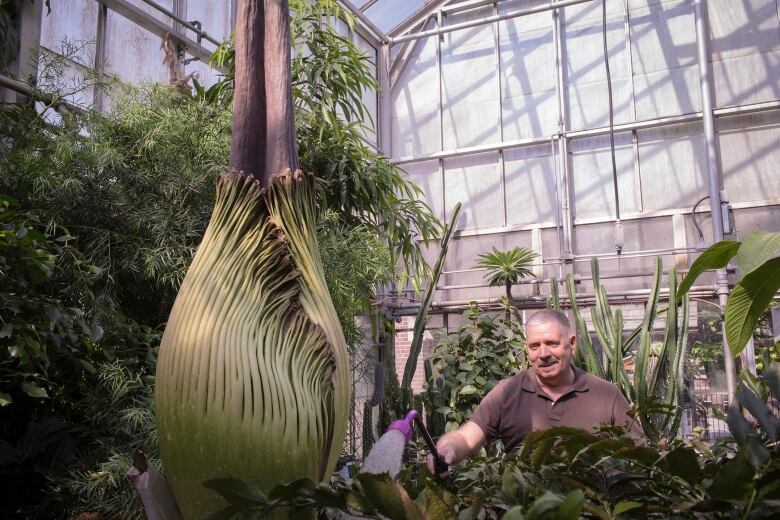Follow that rotting corpse smell to the McMaster greenhouse
'Titan arum' plant expected to be in full bloom in the next few days

You won't smell anything out of the ordinary for now.
But come near the 6-foot-tall titan arum, say, Monday, and things might be different.
"Right now it's not emanating any kind of foul odour," said Arthur Yeas, the keeper of the so-called "corpse flower" named for its rotting-meat smell.
"It's just looking very innocent. I think it'll be in full bloom Monday."
The flower is native to Western Sumatra, Indonesia, and can go five or 10 years between blooms, so the impending bloom is a smell-it-while-you-can experience. The flower has been growing five inches per day and just passed the 6-foot mark.
When the flower does bloom, the greenhouse will be open extended hours for three days, from 9 a.m. to 11 p.m.
Another of Yeas' three corpse flowers bloomed in January. And he said the stinky name is not overstated.
"It smelled really very bad the very first day," he said. "As it gets older, the smell begins to be more like dead pumpkin with the dead body smell mixed in."
That description is for when the smell gets better, if you didn't catch that.
"It's the worst smell that I've smelled any time in my life," Yeas said.
When properly prepared in Sumatra, Yeas said, the flower can be used as food and medicine. Medicinally it's used to treat diarrhea and stomach illness. Say nothing of the person suffering a bout of nausea trying to ingest the stinky treatment.
"Maybe it'll take your mind off the diarrhea and the stomach illness when you smell it," Yeas said.
The plant is listed as vulnerable and "nobody really knows how many are left in the wild," Yeas said. Seventy percent of the rainforest where the flower would grow has been cut to grow oil palms, he said.
After the flower blooms, the flower will collapse. In about a month, the plant will release the dead flower. And in another several months, it will send up another bud most likely for a leaf, which can grow to 20 feet tall. It could be years before the plant sends up another flowering bud.
"Having a plant like this just shows the public the incredible complexity and diversity of the natural world," Yeas said.












_(720p).jpg)


 OFFICIAL HD MUSIC VIDEO.jpg)
.jpg)



























































































